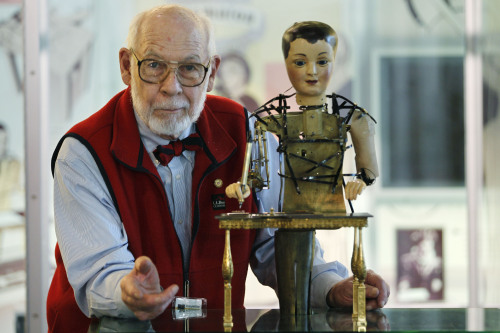PHILADELPHIA (AP) ― The Franklin Institute’s automaton can’t help you find a good sushi place, direct you out of a traffic jam or check your bank balance.
But the automaton, a mechanical doll animated by a complex system of spring-driven motors and brass cams, can write three poems and draw four pictures. And what might be most interesting about this 200-year-old curiosity is its ability to amaze a high-tech culture whose homes, cars and pockets are laden with all kinds of wireless, streaming, talking, mapping gadgetry.
Martin Scorsese’s movie “Hugo,’’ nominated for 11 Academy Awards this weekend, including best picture, has sparked the latest wave of interest in the automated offspring of a real-life 19th-century clockmaker.
The film itself is based on Brian Selznick’s award-winning “The Invention of Hugo Cabret,’’ an illustrated novel about a Parisian boy and a broken automaton with a secret buried inside its mechanical memory. The author learned of the Philadelphia automaton while researching his book and contacted The Franklin Institute.
“That’s when I found out it had hadn’t worked for many years and was at the time in the basement and off-limits,’’ Selznick said. Like in his story, the Philadelphia automaton was broken and once damaged in a fire.
Selznick was permitted to see the automaton in its sorry state, with its head detached and its hand unable to write or draw. Charles Penniman, 83, the machine’s caretaker and guardian for nearly four decades, explained its colorful past and its remarkable former abilities.
“They’re old friends,’’ Selznick said of the man-machine duo. After the visit, Selznick got in touch with mechanical whiz Andy Baron, a pop-up book designer and real-life Hugo working as a technical consultant for the book. He came to Philadelphia and repaired the automaton that museum officials feared was irreparable.
 |
Charles Penniman, 83, caretaker of the The Franklin Institute science museum’s 210-year-old automaton, poses for a photograph at the museum in Philadelphia. (AP-Yonhap News) |
“Charles was there as Andy was fixing the machine,’’ Selznick said. “He must be very happy that it’s the center of attention again.’’
Penniman, who vividly recalls seeing the automaton in The Franklin Institute as a boy in the 1930s, said it has fascinated children and adults for two centuries.
“The mystique of the machine is what it’s all about,’’ he said. “This has a glass opening now so you can see the cams inside ... originally, it would have been covered up so you couldn’t see the mechanism. Either way, there’s mystery about how this kid does what he does.’’
It was made in England around 1800 and traveled throughout Europe as far as St. Petersburg for 40-odd years in touring shows of automata and other mechanical marvels.
From there, things get cloudy. The popular theory is that famous American showman P.T. Barnum brought it to the U.S., possibly displaying it in his Philadelphia museum that burned to the ground in 1851. The automaton, a charred and tangled mess, somehow ended up with a wealthy Philadelphian named John Penn Brock, whose descendants donated it to The Franklin Institute in 1928.
At that time, the Brocks said family lore identified the maker as German inventor Johann Maelzel. After months of work to bring the scorched automaton out of suspended animation ― with no diagrams or manuals to guide him ― museum mechanic Charles Roberts was in for a surprise when he wound its two cranks and flipped an internal lever.
The automaton lowered its porcelain head, smoothly wrote a four-line poem in meticulous penmanship and finished with “Ecrit par L’Automate de Maillardet’’ ― translation: “Written by Maillardet’s Automaton.’’
“In the little boy’s memory, which is here,’’ Penniman said, pointing to the elaborate brass cams seen through the glass floor under the figure’s gilded writing desk, “he told us who made him. We didn’t know. But the kid here ― he knew.’’
Its repertoire consists of two poems in French, one in English, a ship, a Chinese temple, and two Cupid scenes. Each takes about three minutes to complete.
In an extra flourish of showmanship, Maillardet programmed the automaton to pause at times, lifting its hand from the paper and raising its head, as if contemplating what to do next.
“The accuracy after 200 years is incredible,’’ Penniman said. “We still don’t know exactly how Maillardet did it, how the cams work. These were trade secrets, nothing was written down.’’
The boy has been broken and repaired several times since then. Since its 2007 restoration, it’s been the centerpiece of the museum’s “Amazing Machines’’ permanent exhibit. Videos show the automaton in action; it’s not up for a grueling daily performance schedule because of its advanced age and delicate constitution.
Selznick said he was thrilled to have played a part in getting Maillardet’s automaton out of the basement and into public view.
“The automaton lived the story that I had created in my imagination,’’ Selznick said.







![[Weekender] Korea's traditional sauce culture gains global recognition](http://res.heraldm.com/phpwas/restmb_idxmake.php?idx=644&simg=/content/image/2024/11/21/20241121050153_0.jpg)
